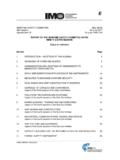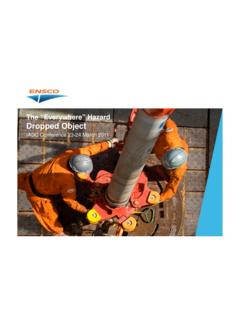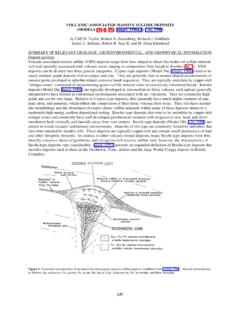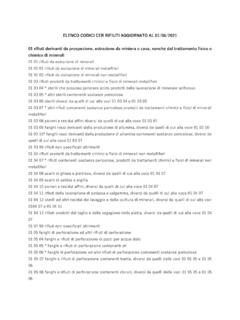Transcription of Introduction - IADC.org
1 DRILLING FLUIDS FL-1. Introduction The principal functions of drilling fluid are to: Drilling fluids are fluids that are used during the drilling of subterranean wells. They provide primary well control of Control subsurface pressures, maintaining well control;. subsurface pressures by a combination of density and any Remove drill cuttings from beneath the bit and circulate additional pressure acting on the fluid column (annular or them to the surface;. surface imposed). They are most often circulated down the Maintain wellbore stability, mechanically and chemi- drill string, out the bit and back up the annulus to the surface cally;. so that drill cuttings are removed from the wellbore. Transmit hydraulic energy to the drill bit and downhole tools;. Drilling fluids have a number of alternative names, acronyms Cool and lubricate the drill string and bit.
2 And slang terms used within Allow adequate for- the industry. The most widely mation evaluation;. used name is mud or drill- Provide a completed ing mud and both these terms wellbore that will produce hy- will be used interchangeably drocarbons;. throughout this chapter. Oth- Suspend or minimize er drilling fluid names and the settling of drill cuttings or acronyms are: water-based weight material when circula- mud (WBM), oil-based mud tion is stopped, yet allow the (OBM), synthetic-based mud Figure FL-1: Drilling fluids are major factors in a successful drilling removal of drill cuttings in the (SBM), non-aqueous fluid program. Courtesy MI-SWACO, a Schlumberger company. surface fluids processing sys- (NAF), invert emulsion fluid tem; and (IEF), high performance water-based mud (HPWBM), drill-in Form a low permeability, thin and tough filter cake fluid (DIF) and reservoir drilling fluid (RDF).
3 Similar to drilling across permeable formations. fluids are so-called completion fluids that are used to finish the well after drilling is completed. The fluids used during The performance of these functions depends upon the type completions are often referred to as workover and comple- of formation being drilled and the various properties of the tion (WOC) fluids, clear brines and/or packer fluids. drilling fluid. Often, compromises are necessary due to a va- riety of factors. The selection and design of a particular drill- Drilling fluid is a major factor in the success of the drilling ing fluid and its properties depends on the complexity of the program and deserves careful study. Discussion in this man- well being drilled, subsurface pressures and temperatures, ual, however, is limited to its general features. A compre- logistics, cost and local experience.
4 Drilling fluid perfor- hensive and more academic text on drilling fluids is Com- mance is also affected by the drilling equipment being used. position and Properties of Drilling and Completion Fluids by Caenn, Darley and Gray. The suppliers of drilling fluid mate- The properties of the drilling fluid should be adjusted to the rials also offer a wide range of publications and numerous hydraulics available for the drilling operation and the well de- articles can be located in the technical literature of the oil sign. Rate of penetration (ROP) and bit life can be improved and gas industry. by optimizing the hydraulic horsepower at the bit, especially for roller cone bits. The ROP and bit life for polycrystalline diamond compact (PDC) cutter bits is improved when an Drilling fluid function and performance adequate flowrate is used with minimal overbalance.
5 Drilling Drilling fluids range from simply water or oil to compressed fluid properties and circulation rates determine the parasitic air and pneumatic fluids to more complex water-based or pressure losses in the drill string and the available pressure at oil-based systems. Drilling fluid additives include weight- the bit for optimized drilling performance. The ROP is also af- ing materials; viscosifiers; filtration control additives; pH/ fected by the density of the mud and nature of the suspended alkalinity control chemicals; dispersants/deflocculants/ solids. Regular and complete tests are essential to the control thinners; surfactants and emulsifiers; shale inhibitors; corro- of mud properties. The interpretation of the results of these sion inhibitors/oxygen scavengers/hydrogen sulfide (H2S) tests and treatments to maintain appropriate fluid properties scavengers; lubricants; and bridging agents/lost circulation is vital to the success of the drilling program.
6 Materials (LCMs). A brief description of these categories is included later in this section. IADC Drilling Manual Copyright 2014. FL-2 DRILLING FLUIDS. Testing drilling fluid properties Rotary Hose Various properties of drilling fluid are monitored Standpipe and adjusted to achieve desired performance. Top Drive Procedures for measuring fluid properties can be found in API Recommended Practice 13B-1. for water-based drilling fluids and Recommend- ed Practice 13B-2 for oil-based drilling fluids. Mud Pump These procedures are revised and extended pe- riodically as improvements are made and new tests are developed. Kelly or Drill Pipe, Pump Discharge Line if Top Drive used Purpose of testing Routine testing is carried out on drilling fluids to determine the following: the density or mud weight; viscosity; gel strengths, filtration rate Mud Cleaning (also called fluid loss); sand content; solids, oil Equipment /.
7 Shale Shaker and water content; and chemical properties. Drill Pipe Density or mud weight Density or mud weight is the mass per unit Annulus volume. In the field, it is measured with a mud Mud Return balance and is most often reported in pounds Line per gallon (lb/gal or ppg); specific gravity or Mud Tank/Pit SG (g/ml); kilograms per cubic meter (kg/cu m); or pounds per cubic foot (lb/cu ft). Density Borehole is used to determine the hydrostatic pressure of the mud column and can also be measured Drill Bit and expressed as a gradient such as pounds per square inch per thousand feet (psi/1,000 ft). This allows for easy calculation of the hydro- Figure FL-2: Basic land rig circulating system. static pressure at any depth. The mud scale is calibrated with water (freshwater weighs Physical operating principles lb/gal and seawater weighs lb/gal).
8 The mud The three main functions of drilling fluids are to: scale has four units scales graduated on the beam: lb/gal or ppg, g/cc, lb/cu ft and psi/1,000 ft. Please refer to the Control subsurface pressures: These pressures are section entitled Calculations and Tables for the appropriate controlled by the hydrostatic pressure of the drilling calculations and unit conversions. fluid plus any surface-imposed pressure on the annulus. While circulating, annular pressure losses also impose Viscosity additional pressure on the wellbore. Hydrostatic Viscosity is a measure of the drilling fluids internal resis- pressure is increased by increasing the density of the tance to flow, or how thick or thin it is. Drilling fluids are drilling fluid. This is normally carried out by adding non-Newtonian, meaning that their viscosity is not constant barite (BaSO4), a high-density inert powder.
9 For all shear rates. These non-Newtonian fluids behave very Circulate drill cuttings from the well: This is dependent differently than liquids like water or oil which are Newtonian on a combination of fluid velocity, fluid viscosity, fluid with a constant viscosity regardless of shear rate. Non-New- density and drill string rotation. tonian drilling fluids are shear thinning such that they have Maintain wellbore stability: This is dependent on the lower viscosity at high-shear rates and higher viscosity at strength of the rocks being drilled, local subsurface low-shear rates. This is desirable for drilling where minimum stresses, differential pressure at the wellbore, drilling pressure losses are wanted for the high-shear conditions in- fluid chemistry, formation composition, filtration side the narrow bore of the drill string. Higher viscosity is control, filter cake quality and bridging solids.
10 Wanted in the low-shear conditions of the larger annulus. Viscosity depends on the viscosity of the base liquid and the IADC Drilling Manual Copyright 2014. DRILLING FLUIDS FL-3. type and concentration of solids in the drilling fluid. Viscos- ity is usually higher for higher density fluids due to the in- creased concentration of weight material such as barite . As a general rule, thicker fluids are needed for larger diameter hole sizes and thinner fluids are needed for smaller hole siz- es which have smaller annular flow areas. Viscosity is measured with two primary tools; a) the Marsh funnel (Figure FL-3) which is used to frequently measure relative changes in viscosity, and b) a direct reading viscom- eter (Figure FL-4), which is used to measure the viscosity, gel strengths, and non-Newtonian characteristics precisely. The Marsh funnel is used to monitor relative changes in vis- cosity and is commonly reported as funnel viscosity.















